Preparation and Electrochemical Characterization of Mesoporous Polyaniline-Silica Nanocomposites as an Electrode Material for Pseudocapacitors
Abstract
:1. Introduction
2. Results and Discussion
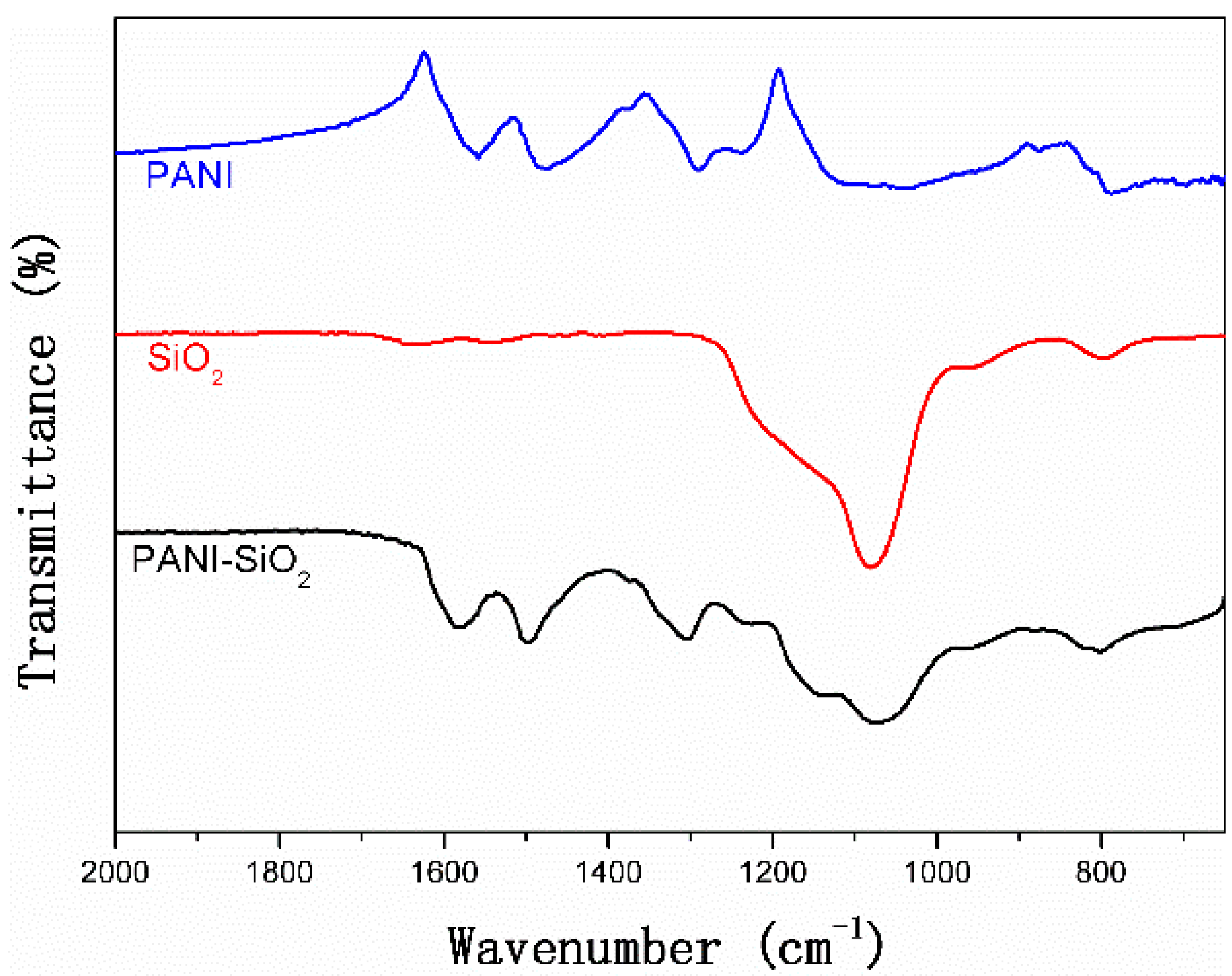

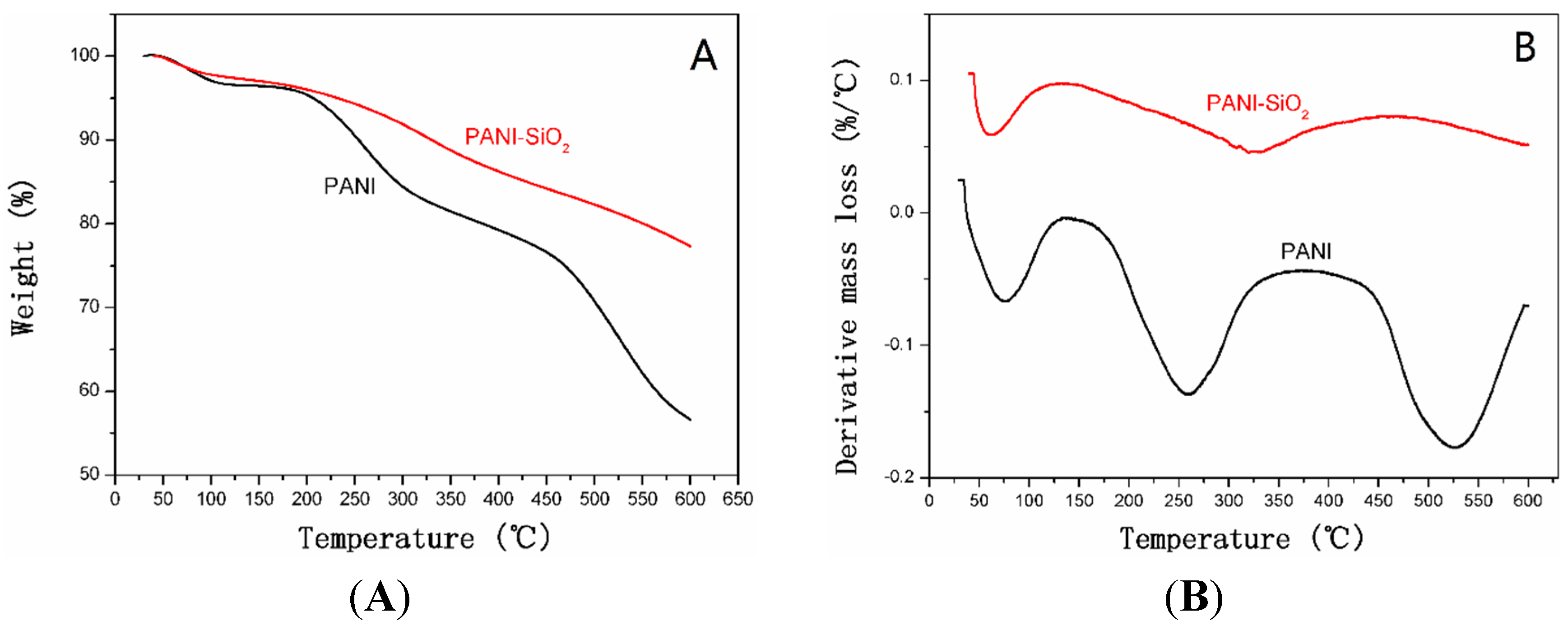


| Electrode | SBET (m2/g) | D (nm) | Vt (cm3/g) |
|---|---|---|---|
| SiO2 | 240.33 | 4.39 | 0.41 |
| PANI-SiO2 | 81.08 | 5.72 | 0.20 |
| PANI | 48.11 | 6.68 | 0.11 |
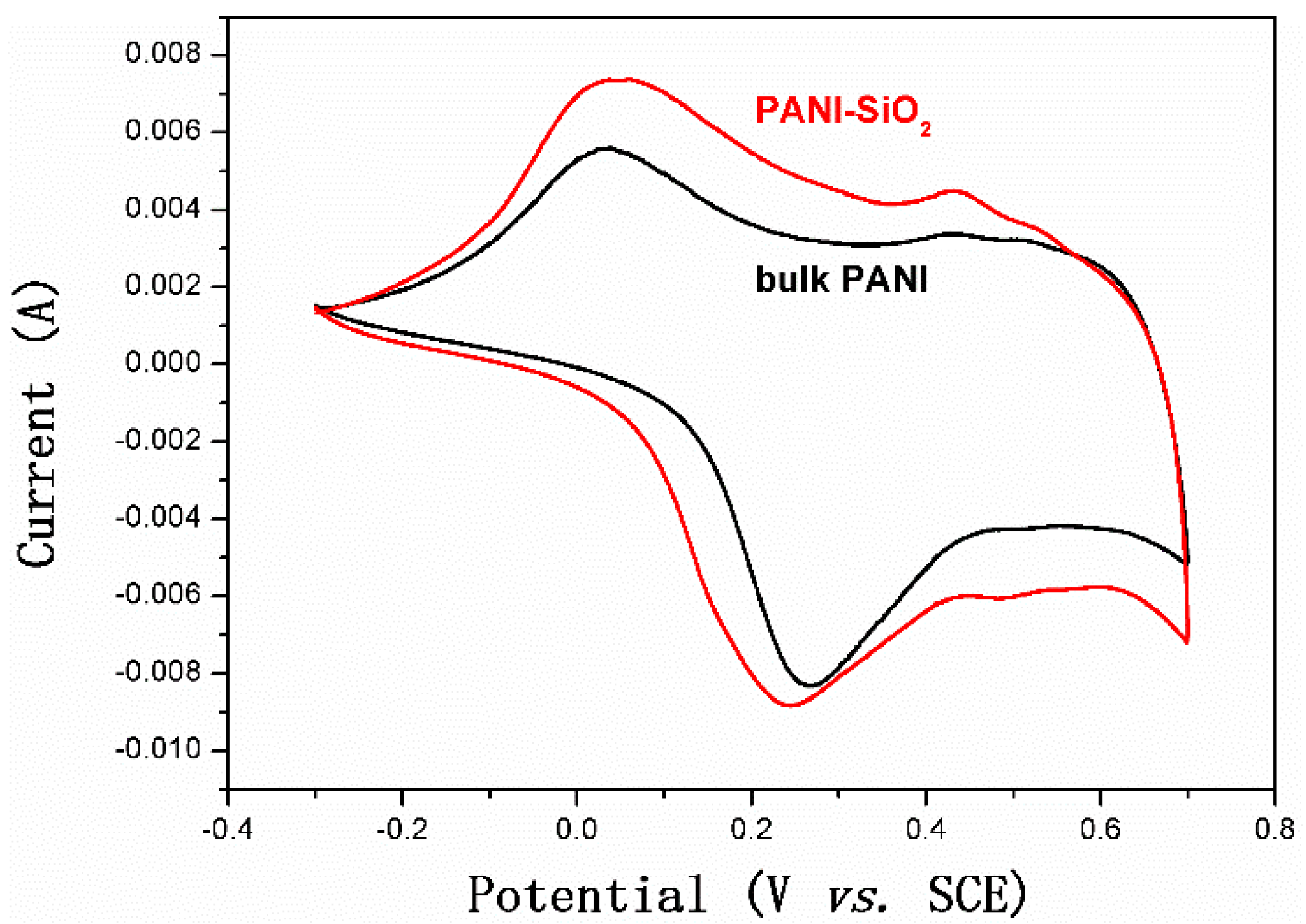
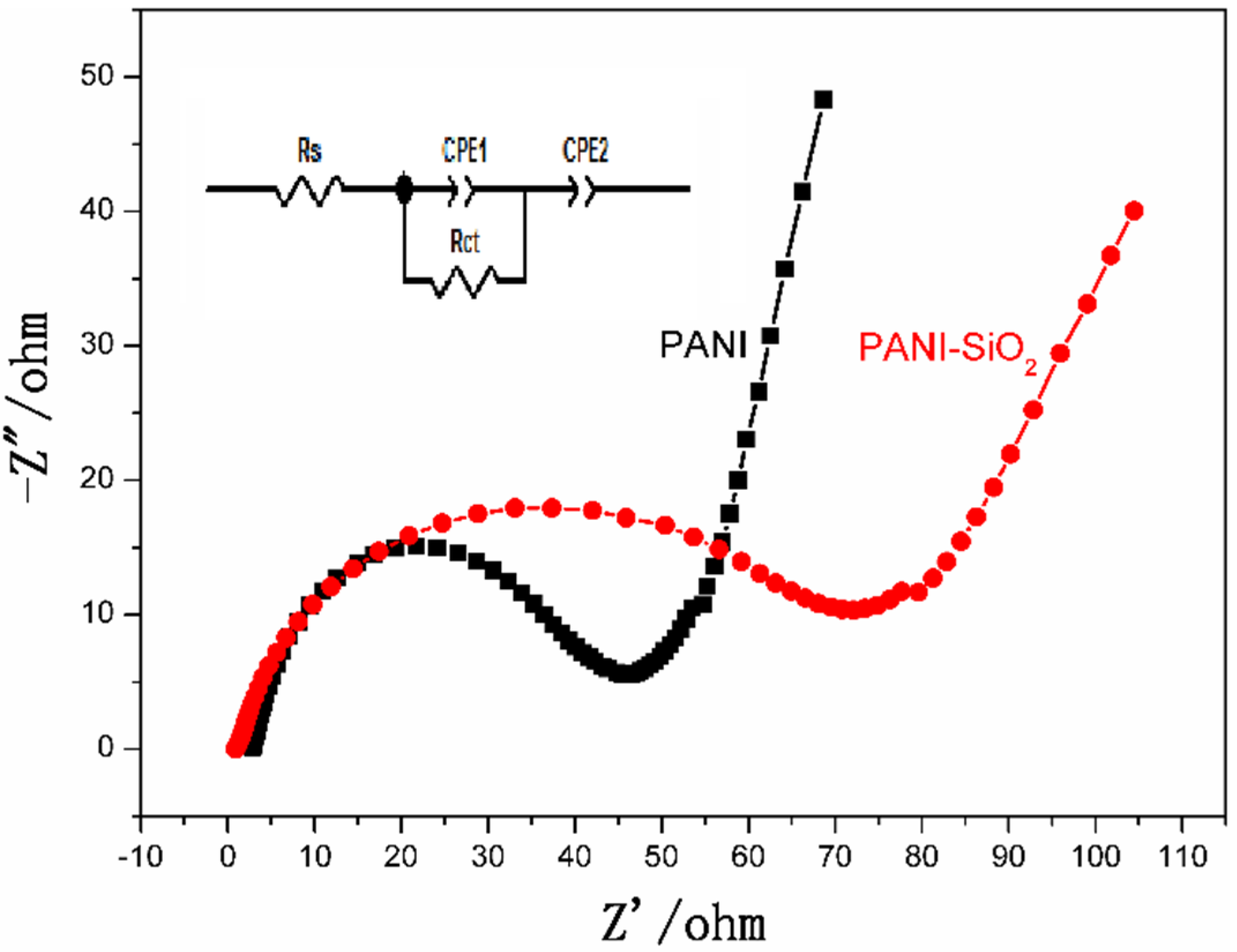
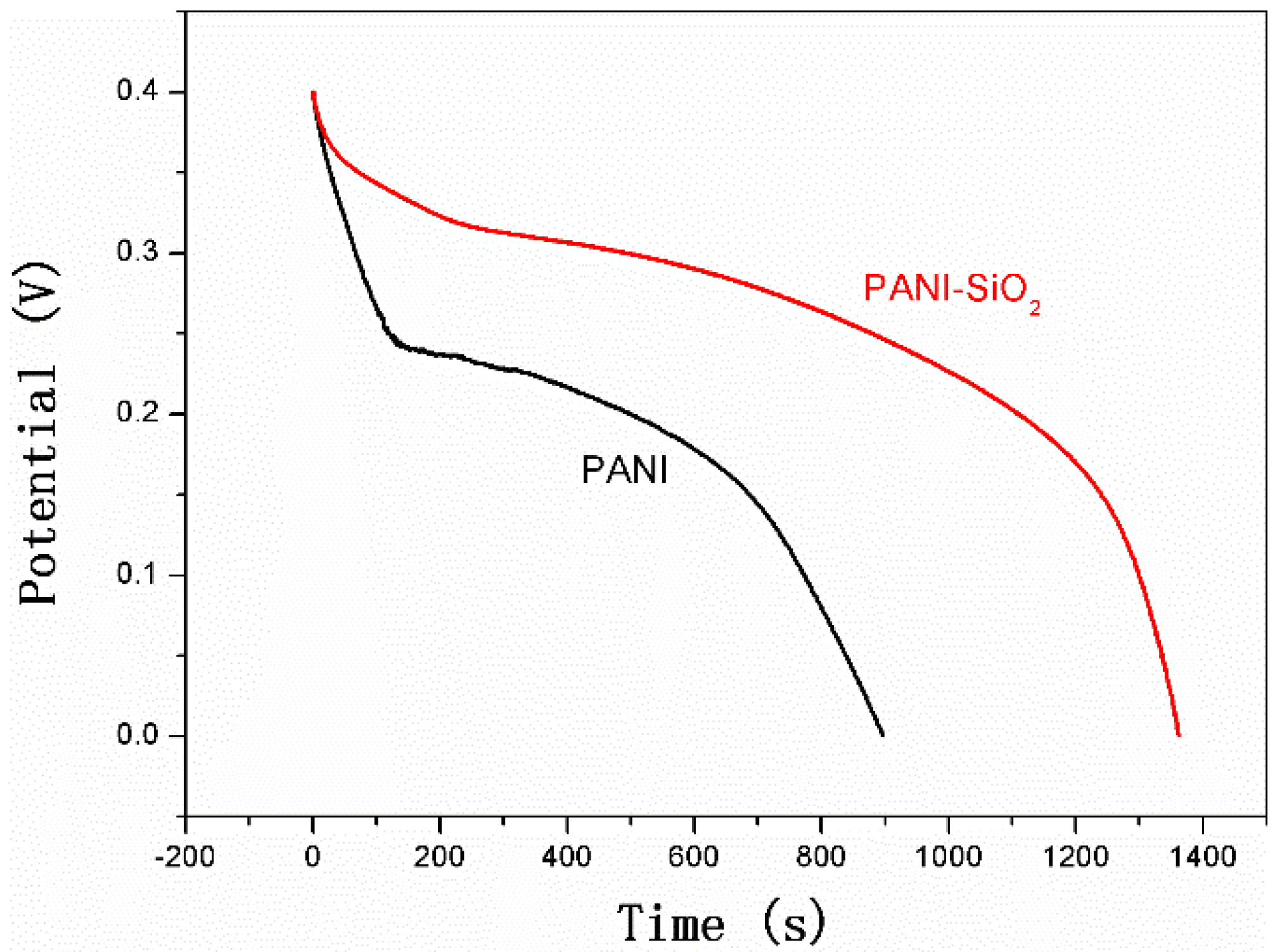
3. Experimental Section
3.1. Chemicals
3.2. Sample Preparation
3.2.1. Preparation of PANI
3.2.2. Preparation of Mesoporous Silica
3.2.3. Preparation of Mesoporous PANI-Silica Nanocomposites
3.3. Characterization
3.3.1. Instruments
3.3.2. Electrochemical Test Method
4. Conclusions
Acknowledgments
Author Contributions
Conflicts of Interest
References
- Simon, P.; Gogotsi, Y. Materials for electrochemical capacitors. Nat. Mater. 2008, 7, 845–854. [Google Scholar] [PubMed]
- Wang, G.; Zhang, L.; Zhang, J. A review of electrode materials for electrochemical supercapacitors. Chem. Soc. Rev. 2012, 41, 797–828. [Google Scholar] [CrossRef] [PubMed]
- Chen, Y.-L.; Chen, P.-C.; Chen, T.-L.; Lee, C.-Y.; Chiu, H.-T. Nanosized MnO2 spines on Au stems for high-performance flexible supercapacitor electrodes. J. Mater. Chem. A 2013, 1, 13301–13307. [Google Scholar] [CrossRef]
- Kodama, M.; Yamashita, J.; Soneda, Y.; Hatori, H.; Kamegawa, K. Preparation and electrochemical characteristics of N-enriched carbon foam. Carbon 2007, 45, 1105–1107. [Google Scholar] [CrossRef]
- Ryu, K.S.; Kim, K.M.; Park, Y.J.; Park, N.-G.; Kang, M.G.; Chang, S.H. Redox supercapacitor using polyaniline doped with Li salt as electrode. Solid State Ionics 2002, 152–153, 861–866. [Google Scholar] [CrossRef]
- Bhadra, S.; Khastgir, D.; Singha, N.K.; Lee, J.H. Progress in preparation, processing and applications of polyaniline. Prog. Polym. Sci. 2009, 34, 783–810. [Google Scholar] [CrossRef]
- Ćirić-Marjanović, G. Recent advances in polyaniline research: Polymerization mechanisms, structural aspects, properties and applications. Synth. Met. 2013, 177, 1–47. [Google Scholar] [CrossRef]
- Deshmukh, P.R.; Pusawale, S.N.; Jamadade, V.S.; Patil, U.M.; Lokhande, C.D. Microwave assisted chemical bath deposited polyaniline films for supercapacitor application. J. Alloy. Compd. 2011, 509, 5064–5069. [Google Scholar] [CrossRef]
- Khosrozadeh, A.; Xing, M.; Wang, Q. A high-capacitance solid-state supercapacitor based on free-standing film of polyaniline and carbon particles. Appl. Energy 2014. [Google Scholar] [CrossRef]
- Liu, Y.; Chen, Z.; Yang, L.; Li, T.; Lv, X. User preference heterogeneous network selection in less subjective ways. Wirel. Pers. Commun. 2014, 76, 813–828. [Google Scholar] [CrossRef]
- Portet, C.; Taberna, P.L.; Simon, P.; Flahaut, E.; Laberty-Robert, C. High power density electrodes for Carbon supercapacitor applications. Electrochim. Acta 2005, 50, 4174–4181. [Google Scholar] [CrossRef] [Green Version]
- Prasad, K.P.S.; Dhawale, D.S.; Joseph, S.; Anand, C.; Wahab, M.A.; Mano, A.; Sathish, C.I.; Balasubramanian, V.V.; Sivakumar, T.; Vinu, A. Post-synthetic functionalization of mesoporous carbon electrodes with copper oxide nanoparticles for supercapacitor application. Microporous Mesoporous Mater. 2013, 172, 77–86. [Google Scholar] [CrossRef]
- Ma, L.; Shen, X.; Zhou, H.; Ji, Z.; Chen, K.; Zhu, G. High performance supercapacitor electrode materials based on porous NiCo2O4 hexagonal nanoplates/reduced graphene oxide composites. Chem. Eng. J. 2015, 262, 980–988. [Google Scholar] [CrossRef]
- Dhawale, D.S.; Vinu, A.; Lokhande, C.D. Stable nanostructured polyaniline electrode for supercapacitor application. Electrochim. Acta 2011, 56, 9482–9487. [Google Scholar] [CrossRef]
- Hür, E.; Varol, G.A.; Arslan, A. The study of polythiophene, poly(3-methylthiophene) and poly(3,4-ethylenedioxythiophene) on pencil graphite electrode as an electrode active material for supercapacitor applications. Synth. Met. 2013, 184, 16–22. [Google Scholar] [CrossRef]
- Shinde, S.S.; Gund, G.S.; Kumbhar, V.S.; Patil, B.H.; Lokhande, C.D. Novel chemical synthesis of polypyrrole thin film electrodes for supercapacitor application. Eur. Polym. J. 2013, 49, 3734–3739. [Google Scholar] [CrossRef]
- Li, L.; Song, H.; Zhang, Q.; Yao, J.; Chen, X. Effect of compounding process on the structure and electrochemical properties of ordered mesoporous carbon/polyaniline composites as electrodes for supercapacitors. J. Power Sour. 2009, 187, 268–274. [Google Scholar] [CrossRef]
- Woo, S.-W.; Dokko, K.; Nakano, H.; Kanamura, K. Incorporation of polyaniline into macropores of three-dimensionally ordered macroporous carbon electrode for electrochemical capacitors. J. Power Sour. 2009, 190, 596–600. [Google Scholar] [CrossRef]
- Kim, B.C.; Kwon, J.S.; Ko, J.M.; Park, J.H.; Too, C.O.; Wallace, G.G. Preparation and enhanced stability of flexible supercapacitor prepared from Nafion/polyaniline nanofiber. Synth. Met. 2010, 160, 94–98. [Google Scholar] [CrossRef]
- Zhao, Y.; Wei, H.; Arowo, M.; Yan, X.; Wu, W.; Chen, J.; Wang, Y.; Guo, Z. Electrochemical energy storage by polyaniline nanofibers: high gravity assisted oxidative polymerization vs. rapid mixing chemical oxidative polymerization. Phys. Chem. Chem. Phys. 2015, 17, 1498–1502. [Google Scholar] [CrossRef] [PubMed]
- Pan, Y.; Mei, Z.; Yang, Z.; Zhang, W.; Pei, B.; Yao, H. Facile synthesis of mesoporous MnO2/C spheres for supercapacitor electrodes. Chem. Eng. J. 2014, 242, 397–403. [Google Scholar] [CrossRef]
- Yan, X.; Tong, X.; Wang, J.; Gong, C.; Zhang, M.; Liang, L. Synthesis of mesoporous NiO nanoflake array and its enhanced electrochemical performance for supercapacitor application. J. Alloy. Compd. 2014, 593, 184–189. [Google Scholar] [CrossRef]
- Yu, M.; Chen, J.; Liu, J.; Li, S.; Ma, Y.; Zhang, J.; An, J. Mesoporous NiCo2O4 nanoneedles grown on 3D graphene-nickel foam for supercapacitor and methanol electro-oxidation. Electrochim. Acta 2015, 151, 99–108. [Google Scholar] [CrossRef]
- Zhao, J.; Lai, C.; Dai, Y.; Xie, J. Pore structure control of mesoporous carbon as supercapacitor material. Mater. Lett. 2007, 61, 4639–4642. [Google Scholar] [CrossRef]
- Cai, J.J.; Kong, L.B.; Zhang, J.; Luo, Y.C.; Kang, L. A novel polyaniline/mesoporous carbon nano-composite electrode for asymmetric supercapacitor. Chin. Chem. Lett. 2010, 21, 1509–1512. [Google Scholar] [CrossRef]
- Zhou, S.; Mo, S.; Zou, W.; Jiang, F.; Zhou, T.; Yuan, D. Preparation of polyaniline/2-dimensional hexagonal mesoporous carbon composite for supercapacitor. Synth. Met. 2011, 161, 1623–1628. [Google Scholar] [CrossRef]
- Huang, K.-J.; Wang, L.; Liu, Y.-J.; Wang, H.-B.; Liu, Y.-M.; Wang, L.-L. Synthesis of polyaniline/2-dimensional graphene analog MoS2 composites for high-performance supercapacitor. Electrochim. Acta 2013, 109, 587–594. [Google Scholar] [CrossRef]
- Zhou, Y.; Qin, Z.-Y.; Li, L.; Zhang, Y.; Wei, Y.-L.; Wang, L.-F.; Zhu, M.-F. Polyaniline/multi-walled carbon nanotube composites with core–shell structures as supercapacitor electrode materials. Electrochim. Acta 2010, 55, 3904–3908. [Google Scholar] [CrossRef]
- Wang, J.-G.; Yang, Y.; Huang, Z.-H.; Kang, F. Interfacial synthesis of mesoporous MnO2/polyaniline hollow spheres and their application in electrochemical capacitors. J. Power Sources 2012, 204, 236–243. [Google Scholar] [CrossRef]
- Salinas-Torres, D.; Montilla, F.; Huerta, F.; Morallón, E. All electrochemical synthesis of polyaniline/silica sol–gel materials. Electrochim. Acta 2011, 56, 3620–3625. [Google Scholar] [CrossRef]
- Feng, X.; Yan, Z.; Chen, N.; Zhang, Y.; Liu, X.; Ma, Y.; Yang, X.; Hou, W. Synthesis of a graphene/polyaniline/MCM-41 nanocomposite and its application as a supercapacitor. New J. Chem. 2013, 37, 2203–2209. [Google Scholar] [CrossRef]
- Gu, H.; Wei, H.; Guo, J.; Haldolaarachige, N.; Young, D.P.; Wei, S.; Guo, Z. Hexavalent chromium synthesized polyaniline nanostructures: Magnetoresistance and electrochemical energy storage behaviors. Polymer 2013, 54, 5974–5985. [Google Scholar] [CrossRef]
- Wei, H.; Gu, H.; Guo, J.; Wei, S.; Liu, J.; Guo, Z. Silica Doped Nanopolyaniline with Endured Electrochemical Energy Storage and the Magnetic Field Effects. J. Phys. Chem. C 2013, 117, 13000–13010. [Google Scholar] [CrossRef]
- Wei, H.; Zhu, J.; Wu, S.; Wei, S.; Guo, Z. Electrochromic polyaniline/graphite oxide nanocomposites with endured electrochemical energy storage. Polymer 2013, 54, 1820–1831. [Google Scholar] [CrossRef]
- Wei, H.; Yan, X.; Wu, S.; Luo, Z.; Wei, S.; Guo, Z. Electropolymerized polyaniline stabilized tungsten oxide nanocomposite films: Electrochromic behavior and electrochemical energy storage. J. Phys. Chem. C 2012, 116, 25052–25064. [Google Scholar] [CrossRef]
- Zhang, X.; Zhu, J.; Haldolaarachchige, N.; Ryu, J.; Young, D.P.; Wei, S.; Guo, Z. Synthetic process engineered polyaniline nanostructures with tunable morphology and physical properties. Polymer 2012, 53, 2109–2120. [Google Scholar] [CrossRef]
- Zhu, J.; Chen, M.; Qu, H.; Zhang, X.; Wei, H.; Luo, Z.; Colorado, H.A.; Wei, S.; Guo, Z. Interfacial polymerized polyaniline/graphite oxide nanocomposites toward electrochemical energy storage. Polymer 2012, 53, 5953–5964. [Google Scholar] [CrossRef]
- Gu, H.; Huang, Y.; Zhang, X.; Wang, Q.; Zhu, J.; Shao, L.; Haldolaarachchige, N.; Young, D.P.; Wei, S.; Guo, Z. Magnetoresistive polyaniline-magnetite nanocomposites with negative dielectrical properties. Polymer 2012, 53, 801–809. [Google Scholar] [CrossRef]
- Gu, H.; Guo, J.; He, Q.; Tadakamalla, S.; Zhang, X.; Yan, X.; Huang, Y.; Colorado, H.A.; Wei, S.; Guo, Z. Flame-retardant epoxy resin nanocomposites reinforced with polyaniline-stabilized silica nanoparticles. Ind. Eng. Chem. Res. 2013, 52, 7718–7728. [Google Scholar] [CrossRef]
- Wang, Y.; Zhao, Q.; Han, N.; Bai, L.; Li, J.; Liu, J.; Che, E.; Hu, L.; Zhang, Q.; Jiang, T.; et al. Mesoporous silica nanoparticles in drug delivery and biomedical applications. Nanomed.: Nanotechnol. Biol. Med. 2015, 11, 313–327. [Google Scholar] [CrossRef]
- Wakefield, G.; Adair, M.; Gardener, M.; Greiner, D.; Kaufmann, C.A.; Moghal, J. Mesoporous silica nanocomposite antireflective coating for Cu(In,Ga)Se2 thin film solar cells. Sol. Energ. Mat. C 2015, 134, 359–363. [Google Scholar] [CrossRef]
- Xu, D.; Huang, Z.; Han, L.; Yao, Y.; Che, S. Amphiphilic ABC triblock terpolymer templated large-pore mesoporous silicas. Mater. Lett. 2015, 141, 176–179. [Google Scholar] [CrossRef]
- Shao, H.; Zhou, H.; Guo, X.; Tao, Y.; Jiang, T.; Qin, M. Chromium catalysts supported on mesoporous silica for ethylene tetramerization: Effect of the porous structure of the supports. Catal. Commun. 2015, 60, 14–18. [Google Scholar] [CrossRef]
- Dou, Y.Q.; Zhai, Y.; Zeng, F.; Liu, X.X.; Tu, B.; Zhao, D. Encapsulation of polyaniline in 3-D interconnected mesopores of silica KIT-6. J. Colloid Interface Sci. 2010, 341, 353–358. [Google Scholar] [CrossRef] [PubMed]
- Chen, S.; Zhitomirsky, I. Polypyrrole coated carbon nanotubes for supercapacitors, prepared using indigo carmine as a dispersant and dopant. Mater. Lett. 2014, 135, 47–50. [Google Scholar] [CrossRef]
- Zhu, Y.; Liu, E.; Luo, Z.; Hu, T.; Liu, T.; Li, Z.; Zhao, Q. A hydroquinone redox electrolyte for polyaniline/SnO2 supercapacitors. Electrochim. Acta 2014, 118, 106–111. [Google Scholar] [CrossRef]
- Roldán, S.; Granda, M.; Menéndez, R.; Santamaría, R.; Blanco, C. Supercapacitor modified with methylene blue as redox active electrolyte. Electrochim. Acta 2012, 83, 241–246. [Google Scholar] [CrossRef]
- Zu, L.; Li, R.; Shi, Y.; Lian, H.; Liu, Y.; Cui, X.; Bai, Z. Synthesis and characterization of full interpenetrating structure mesoporous polycarbonate-silica spheres and p-phenylenediamine adsorption. J. Colloid Interface Sci. 2014, 419, 107–113. [Google Scholar] [CrossRef] [PubMed]
- Gu, H.; Guo, J.; Zhang, X.; He, Q.; Huang, Y.; Colorado, H.A.; Haldolaarachchige, N.; Xin, H.; Young, D.P.; Wei, S.; et al. Giant magnetoresistive phosphoric acid doped polyaniline–silica nanocomposites. J. Phys. Chem. C 2013, 117, 6426–6436. [Google Scholar] [CrossRef]
- Chaudhari, H.K.; Kelkar, D.S. Investigation of structure and electrical conductivity in doped polyaniline. Polym. Int. 1997, 42, 380–384. [Google Scholar] [CrossRef]
- Wu, W.; Pan, D.; Li, Y.; Zhao, G.; Jing, L.; Chen, S. Facile fabrication of polyaniline nanotubes using the self-assembly behavior based on the hydrogen bonding: a mechanistic study and application in high-performance electrochemical supercapacitor electrode. Electrochim. Acta 2015, 152, 126–134. [Google Scholar] [CrossRef]
- Shan, Y.; Gao, L. Synthesis, characterization and optical properties of CdS nanoparticles confined in SBA-15. Mater. Chem. Phys. 2005, 89, 412–416. [Google Scholar] [CrossRef]
- Lee, Y.W.; Do, K.; Lee, T.H.; Jeon, S.S.; Yoon, W.J.; Kim, C.; Ko, J.; Im, S.S. Iodine vapor doped polyaniline nanoparticles counter electrodes for dye-sensitized solar cells. Synth. Met. 2013, 174, 6–13. [Google Scholar] [CrossRef]
- Xiong, S.; Yang, F.; Jiang, H.; Ma, J.; Lu, X. Covalently bonded polyaniline/fullerene hybrids with coral-like morphology for high-performance supercapacitor. Electrochim. Acta 2012, 85, 235–242. [Google Scholar] [CrossRef]
- Sowa, I.; Kocjan, R.; Wójciak-Kosior, M.; Świeboda, R.; Zajdel, D.; Hajnos, M. Physicochemical properties of silica gel coated with a thin layer of polyaniline (PANI) and its application in non-suppressed ion chromatography. Talanta 2013, 115, 451–456. [Google Scholar] [CrossRef] [PubMed]
- Ghenaatian, H.R.; Mousavi, M.F.; Kazemi, S.H.; Shamsipur, M. Electrochemical investigations of self-doped polyaniline nanofibers as a new electroactive material for high performance redox supercapacitor. Synth. Met. 2009, 159, 1717–1722. [Google Scholar] [CrossRef]
- Han, L.; Gao, C.; Wu, X.; Chen, Q.; Shu, P.; Ding, Z.; Che, S. Anionic surfactants templating route for synthesizing silica hollow spheres with different shell porosity. Solid State Sci. 2011, 13, 721–728. [Google Scholar] [CrossRef]
© 2015 by the authors; licensee MDPI, Basel, Switzerland. This article is an open access article distributed under the terms and conditions of the Creative Commons Attribution license (http://creativecommons.org/licenses/by/4.0/).
Share and Cite
Zu, L.; Cui, X.; Jiang, Y.; Hu, Z.; Lian, H.; Liu, Y.; Jin, Y.; Li, Y.; Wang, X. Preparation and Electrochemical Characterization of Mesoporous Polyaniline-Silica Nanocomposites as an Electrode Material for Pseudocapacitors. Materials 2015, 8, 1369-1383. https://doi.org/10.3390/ma8041369
Zu L, Cui X, Jiang Y, Hu Z, Lian H, Liu Y, Jin Y, Li Y, Wang X. Preparation and Electrochemical Characterization of Mesoporous Polyaniline-Silica Nanocomposites as an Electrode Material for Pseudocapacitors. Materials. 2015; 8(4):1369-1383. https://doi.org/10.3390/ma8041369
Chicago/Turabian StyleZu, Lei, Xiuguo Cui, Yanhua Jiang, Zhongkai Hu, Huiqin Lian, Yang Liu, Yushun Jin, Yan Li, and Xiaodong Wang. 2015. "Preparation and Electrochemical Characterization of Mesoporous Polyaniline-Silica Nanocomposites as an Electrode Material for Pseudocapacitors" Materials 8, no. 4: 1369-1383. https://doi.org/10.3390/ma8041369






